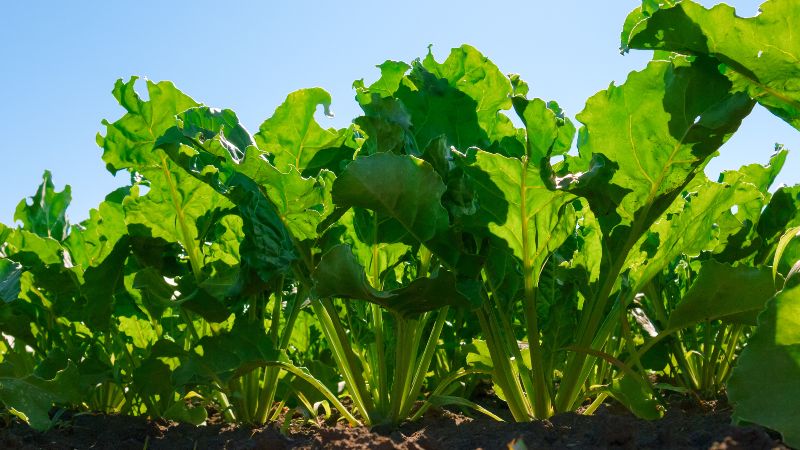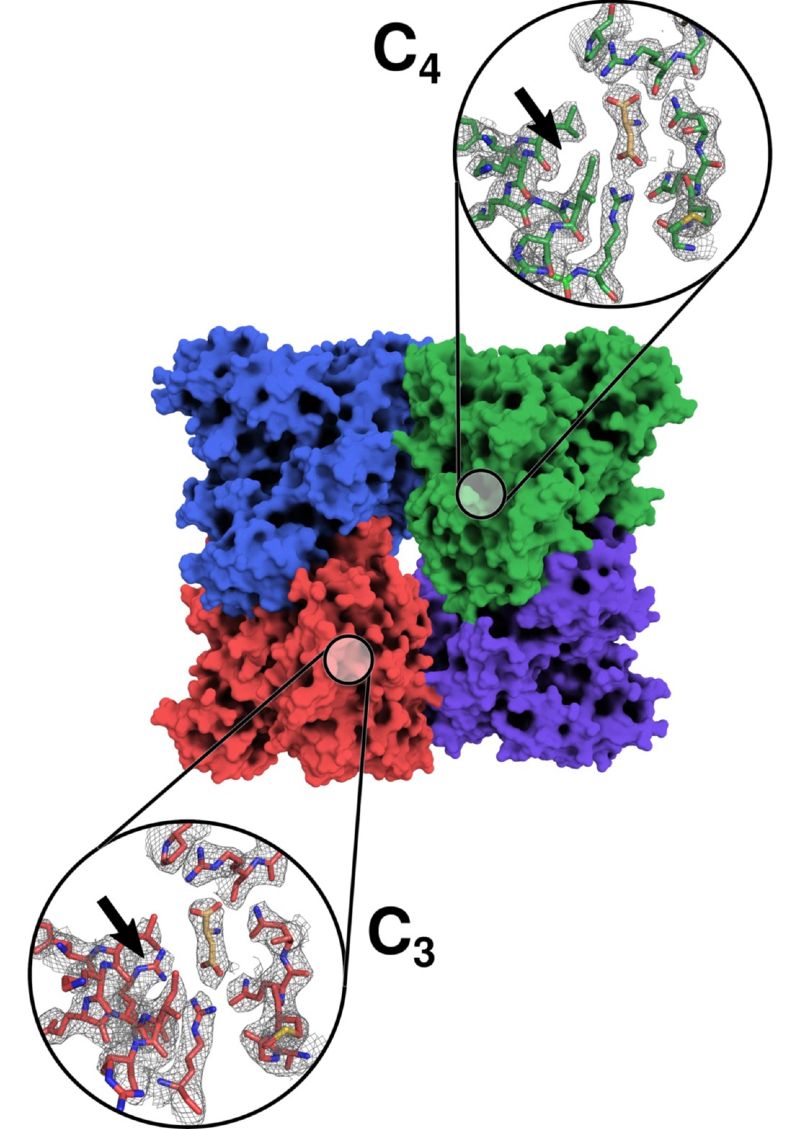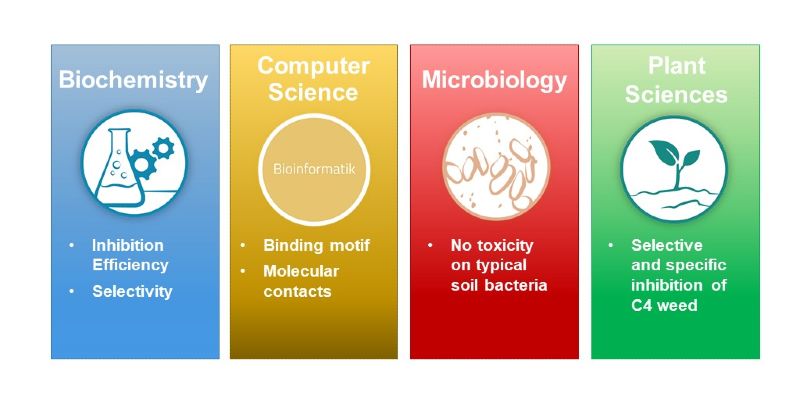
A small but subtle difference in the photosynthesis pathways of many crop plants and associated yield-reducing weeds opens the door for BioSC scientists for selective and sustainable plant protection. Key elements in this concept are an enzyme that is substantially involved in biomass production in many weeds, and a natural substance from wood waste that inhibits it.
Domestic and global agriculture will face numerous challenges over the coming years to ensure the sustainable supply of the population with food and other agricultural products. These include the increasing shortage of the production factors soil and water, the strong dependence of harvest yields on fertilizers and plant protection products, as well as increasing climate change. Current climate models forecast increasingly prolonged droughts and higher average temperatures in summer, the main vegetation period in our agriculture.

Small difference – great effect
The metabolic pathway by which our crop plants form nutrients from sunlight, water, and carbon dioxide is not designed to tolerate prolonged drought or high temperatures. Domestic crop plants that use this metabolic pathway, known as “C3 photosynthesis”, for their growth and development, include oilseed rape and sugar beet. In contrast to these two typical representatives of the C3 photosynthesis pathway, common amaranth, which is adapted to drier and warmer habitats, as well as many other ubiquitous, highly aggressive weeds use another metabolic pathway for their growth and development. This pathway, known as “C4 photosynthesis”, makes these plants exceptionally strong competitors of our crop plants, particularly with regard to the coming climate changes.
Investigation of the C4 pathway and how it differs from the C3 metabolism applied by most crop plants was the focus of the BioSC Boost Fund Project C4-PSH. The objective of the project was to identify molecular differences in the two photosynthesis pathways which can be used as a target for developing environmental-friendly plant protection products that specifically affect the C4 pathway used by weeds but not the C3 pathway used by crop plants.
Biochemical and structural studies at the Heinrich Heine University in Düsseldorf resulted in the identification of phosphoenolpyruvate carboxylase (PEPC), a key enzyme of the C4 photosynthesis pathway, as an effective target. Although this enzyme is also present in C3 plants, it is not of crucial importance for their growth and development. In contrast, C4 plants cannot grow or survive without a functional form of this enzyme. By comparing the molecular structure of the C4 form with the enzyme isoform found in C3 plants, the Düsseldorf team was able to identify differences in a specific binding area of this complex molecule that can be used to shut down enzyme function.

Meticulous search pays off
Based on the structural differences of the two enzyme isoforms, the researchers used computer-based methods to identify a number of substances that bind to the C4 isoform but not or only weakly to the C3 form. They screened the most promising candidates from comprehensive substance libraries consisting of more than 20 million compounds. In these analyses okanin, a natural substance, was identified which almost perfectly fits into the binding site of the C4 enzyme. Although okanin can be produced synthetically, the natural product is also available by direct extraction from the wood of various industrially used tree species. In contrast to the specific binding to C4 PEPCs, the compound shows no or extremely limited access to the corresponding binding pocket in C3 PEPC. Subsequent laboratory experiments with both purified PEPC isoforms confirmed the selective inhibition of the C4 enzyme.
Comparative plant studies at Forschungszentrum Jülich proved that the natural substance okanin not only causes the inhibition of the purified C4 phosphoenolpyruvate carboxylase in the test tube but also inhibits the growth of typical C4 weeds without affecting C3 crop plants such as oilseed rape and sugar beet. Microbial tests carried out in the Jülich laboratories also showed that okanin has no negative effects on typical representatives of the bacterial soil flora. Okanin as well as derived natural and synthetic derivatives are thus attractive new compounds for selective plant protection.
The interdisciplinary research in the fields of structural research, molecular bioinformatics, microbiology, and plant sciences in the framework of the C4-PSH project, therefore, showed how the discovery of an environmentally friendly plant protection product can succeed and initial basic research can result in applied, socially relevant research.
Project Coordinator
Prof. Dr. Georg Groth
Institute of Biochemical Plant Physiology, HHU Düsseldorf
Email
Participating Core Groups
Prof. Dr. Georg Groth, Dr. Giang Nguyen
Institute of Biochemical Plant Physiology, HHU Düsseldorf
Prof. Dr. Holger Gohlke, Dr. German Erlenkamp
Computational Pharmaceutical Chemistry and Molecular Bioinformatics, HHU Düsseldorf
Prof. Dr. Michael Bott, Dr. Andreas Küberl
IBG-1 Biotechnology, Forschungszentrum Jülich
Prof. Dr. Ulrich Schurr, Dr. Fabio Fiorani
IBG-2 Plant Sciences, Forschungszentrum Jülich
Funding Period
01.01.2014 – 31.12.2015
Funding
C4-PSH is part of the NRW-Strategieprojekt BioSC and thus funded by the Ministry of Culture and Science of the German State of North Rhine-Westphalia.
Publikationen
Nguyen, GT, Erlenkamp, G, Jack, O, Kuberl, A, Bott, M, Fiorani, F, Gohlke, H and Groth, G (2016). Chalcone-based selective inhibitors of a c4 plant key enzyme as novel potential herbicides. Sci Rep 6: 27333.
Paulus, JK, Forster, K and Groth, G (2014). Direct and selective small-molecule inhibition of photosynthetic pep carboxylase: New approach to combat c4 weeds in arable crops. FEBS Lett 588(12): 2101-2106.